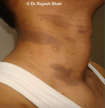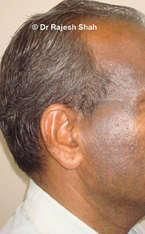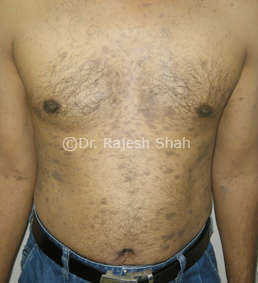Lichen Planus Pigmentosus Treatment
Lichen Planus Pigmentosa (LPP) is an uncommon skin disorder resembling Lichen Planus. This presents with oval grayish (turning blackish) brown marks on the face and neck or trunk and limbs without an inflammatory phase. LPP has a tendency to increase over time and could spread to larger body areas such as the neck, face, upper arms, forearms, back, abdomen, thighs, and legs. It may or may not spread in every person having it. In many cases, it could turn out to be extensive, and that could pose a huge personal and social challenge to the patients.
 The skin in the affected area becomes dry, dark, and hyperpigmented, and the area spreads at a slow pace. It may present in the form of sporadic spots, or on bilateral symmetrical locations, few scattered spots, or big patches. In some patients, the patches are small or large at times. The patches may remain steady or spread.
The skin in the affected area becomes dry, dark, and hyperpigmented, and the area spreads at a slow pace. It may present in the form of sporadic spots, or on bilateral symmetrical locations, few scattered spots, or big patches. In some patients, the patches are small or large at times. The patches may remain steady or spread.
There is generally no itching or minimal itching. There are no eruptions or elevated lesions, as compared to Lichen Planus.
 This has a genetic predisposition in an estimated 30% of cases. It is seen equally in males and females, more common in young adults and the elderly.
This has a genetic predisposition in an estimated 30% of cases. It is seen equally in males and females, more common in young adults and the elderly.
It does not cause any major discomfort, the chief concern being cosmetic. The most common sites affected are the face, arms, and neck.
A trained physician can diagnose it on examination; a biopsy is confirmatory. LPP is a pigmentary disorder of autoimmune origin. In many patients, it could change the way one would approach life, as it may seriously impact the look of the individual. Especially when it affects females, LPP could turn out to be a nightmare.
The most important thing in treating LPP is to bring it under control and slow down or stop its progress. If treated in the early stage, it is possible to control the spread of the disease and bring it under control. Also, the next step is to make the spots as light as possible. It may not be possible to reverse it fully, but some partial relief is possible in most cases using homeopathy.
The classical findings are:
01 The eruption of brownish-black, discrete, non-confluent, asymptomatic macules involving the neck, trunk, and proximal extremities
02 Absence of any preceding inflammatory lesions
03 No previous drug exposure.
Conventional treatment:
The use of local cortisone is the most common mode for the treatment of LPP.
Homeopathic Treatment:
 The condition takes a long time to evolve and is slow to respond to treatment. Long-term homeopathic treatment gives good results, to control the further spread, to stop the disease activity, and to reverse the hyperpigmentation to an extent. Complete recovery from hyperpigmentation may not be possible in most cases. We have treated and documented a good number of cases (over 200 cases as of March 2022) and have shown great control and some definite recovery in many cases.
The condition takes a long time to evolve and is slow to respond to treatment. Long-term homeopathic treatment gives good results, to control the further spread, to stop the disease activity, and to reverse the hyperpigmentation to an extent. Complete recovery from hyperpigmentation may not be possible in most cases. We have treated and documented a good number of cases (over 200 cases as of March 2022) and have shown great control and some definite recovery in many cases.
Other variants of Lichen Planus Case studies of Lichen Planus Pigmentosa
Lichen Planus Pigmentosa affected areas






Written & Approved by-
Dr. Rajesh Shah
M.D. (Hom.)